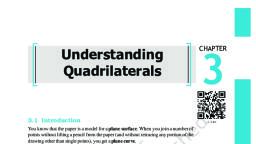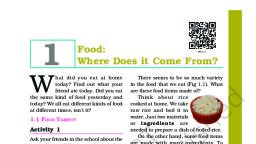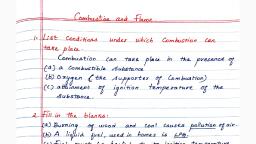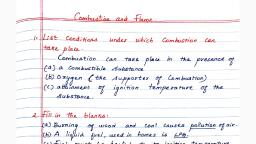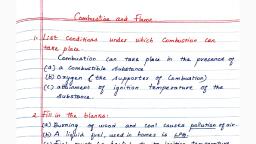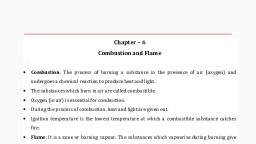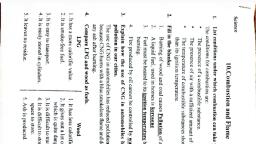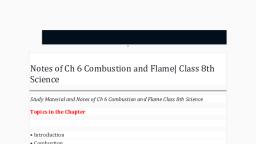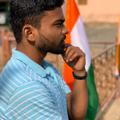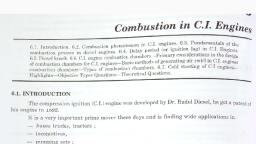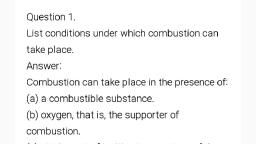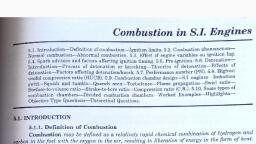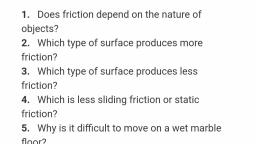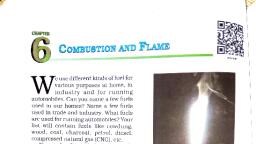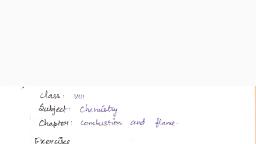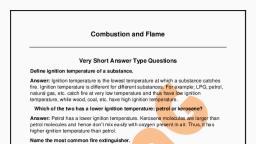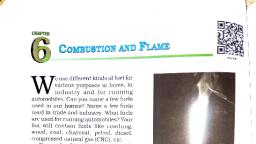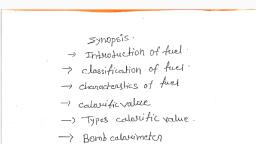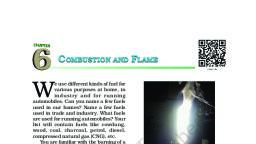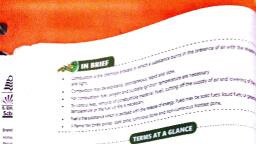Page 1 :
COMBUSTION, , AND, , FLAME, , W, , e use different kinds of fuel for, various purposes at home, in, industry and for running, automobiles. Can you name a few fuels, used in our homes? Name a few fuels, used in trade and industry. What fuels, are used for running automobiles? Your, list will contain fuels like cowdung,, wood, coal, charcoal, petrol, diesel,, compressed natural gas (CNG), etc., You are familiar with the burning of a, candle. What is the difference between the, burning of a candle and the burning of a, fuel like coal? May be you were able to, guess right: candle burns with a flame, whereas coal does not. Similarly, you will, find many other materials burning, without a flame. Let us study the chemical, process of burning and the types of flame, produced during this process., , h, s, , T, i, l, R, b, E, u, C, p, N re, © e, b, o, t, t, , 6.1 What is Combustion?, , Recall the activity of burning of, magnesium ribbon performed in Class, VII. We learnt that magnesium burns to, form magnesium oxide and produces, heat and light (Fig. 6.1)., We can perform a similar activity with, a piece of charcoal. Hold the piece with, a pair of tongs and bring it near the, flame of a candle or a Bunsen burner., What do you observe?, We find that charcoal burns in air., We know that coal, too, burns in air, producing carbon dioxide, heat and, light., , o, n, , d, e, , Fig. 6.1 : Burning of magnesium, , A chemical process in which a, substance reacts with oxygen to give off, heat is called combustion. The, substance that undergoes combustion, is said to be combustible. It is also called, a fuel. The fuel may be solid, liquid or, gas. Sometimes, light is also given off, during combustion, either as a flame or, as a glow., In the reactions mentioned above, magnesium and charcoal are, combustible substances., , We were told that, food is a fuel for, our body.
Page 2 :
Activity 6.2, Rightly so. In our body, food is broken down by, reaction with oxygen and, heat is produced. We, learnt that in Class VII., , Caution : Be careful while handling, burning candle., Fix a lighted candle on a table. Put, a glass chimney over the candle and, rest it on a few wooden blocks in, such a way that air can enter the, , d, e, , Activity 6.1, Collect some materials like straw,, matchsticks, kerosene oil, paper,, iron nails, stone pieces, glass, etc., Under the supervision of your, teacher try to burn each of these, materials one by one. If combustion, takes place mark the material, combustible, otherwise mark it as, non-combustible (Table 6.1)., , T, i, l, R, b, E, u, C, p, N re, © e, b, o, t, t, , Table 6.1 Combustible and noncombustible Substances, Material, , Combustible, , Wood, Paper, Iron nails, Kerosene oil, Stone piece, Straw, , o, n, , Charcoal, , Matchsticks, Glass, , h, s, , Noncombustible, , Can you name some more, substances which are combustible? You, can add those to Table 6.1., Let us investigate conditions under, which combustion takes place., COMBUSTION AND FLAME, , (a), (b), (c), Fig. 6.2: Experiment to show that air is, essential for burning, , chimney [Fig. 6.2(a)]. Observe what, happens to the flame. Now remove, the blocks and let the chimney rest, on the table [Fig. 6.2(b)]. Again, observe the flame. Finally, put a, glass plate over the chimney [Fig., 6.2(c)]. Watch the flame again. What, happens in the three cases? Does, the flame flicker off? Does it flicker, and give smoke? Does it burn, unaffected? Can you infer anything, at all about the role played by air in, the process of burning?, , We find that for combustion, air is, necessary. The candle burns freely in, case (a) when air can enter the, chimney from below. In case (b), when, air does not enter the chimney from, below, the flame flickers and produces, smoke. In case (c), the flame finally, goes off because the air is not, available., 65
Page 3 :
is covered with a blanket to extinguish, fire (Fig. 6.3). Can you guess why?, We have read that the sun, produces its own heat and, light. Is it also some kind of, combustion?, In the sun, heat and light are, produced by nuclear reactions. You, will learn about this process in higher, classes., , Activity 6.3, , h, s, , Now recall some of your experiences., Does a matchstick burn by itself?, How does it burn?, You must have had an experience of, burning a piece of paper. Does it burn, when a burning matchstick is brought, near it?, Can you burn a piece of wood by, bringing a lighted matchstick near it?, Why do you have to use paper or, kerosene oil to start fire in wood or coal?, Have you heard of forest fires?, , T, i, l, R, b, E, u, C, p, N re, © e, b, o, t, t, , Place a piece of burning wood or, charcoal on an iron plate or Tawa., Cover it with a glass jar or a, tumbler, or a transparent plastic jar., Observe what happens. Does, charcoal stop burning after, sometime? Can you think of the, reason why it stops burning?, , You might have heard that when the, clothes of a person catch fire, the person, , d, e, , Fig. 6.3 : Blanket wrapped around a person, whose clothes caught fire, , During extreme heat, of summer, at some, places dry grasses, catch fire. From, grasses, it spreads to, trees, and very soon, the whole forest is on, fire (Fig. 6.4). It is, very difficult to, control such fires., , o, n, , Fig. 6.4 : Forest fire, 66, , SCIENCE
Page 4 :
Do these experiences tell you that, different substances catch fire at, different temperatures?, The lowest temperature at which a, substance catches fire is called its, ignition temperature., Can you tell now why a matchstick, does not catch fire on its own at room, temperature? Why does the matchstick, start burning on rubbing it on the side, of the matchbox?, The history of the matchstick is very, old. More than five thousand years, ago small pieces of pinewood dipped, in sulphur were used as matches in, ancient Egypt. The modern safety, match was developed only about two, hundred years ago., A mixture of antimony trisulphide,, potassium chlorate and white, phosphorus with some glue and, starch was applied on the head of a, match made of suitable wood. When, struck against a rough surface, white, phosphorus got ignited due to the heat, of friction. This started the, combustion of the match. However,, white phosphorus proved to be, dangerous both for the workers, involved in the manufacturing of, matches and for the users., These days the head of the safety, match contains only antimony, trisulphide and potassium chlorate., The rubbing surface has powdered, glass and a little red phosphorus, (which is much less dangerous)., When the match is struck against the, rubbing, surface,, some, red, phosphorus gets converted into white, phosphorus. This immediately reacts, with potassium chlorate in the, matchstick head to produce enough, heat to ignite antimony trisulphide, and start the combustion., , We find that a combustible substance, cannot catch fire or burn as long as its, temperature is lower than its ignition, temperature. Have you ever seen, cooking oil catching fire when a frying, pan is kept for long on a burning stove?, Kerosene oil and wood do not catch fire, on their own at room temperature. But,, if kerosene oil is heated a little, it will, catches fire. But if wood is heated a, little, it would still not catch fire. Does, it mean that ignition temperature of, kerosene oil is lower than that of wood?, Does it mean that we need to take, special care in storing kerosene oil? The, following activity shows that it is, essential for a substance to reach, ignition temperature to burn., , h, s, , T, i, l, R, b, E, u, C, p, N re, © e, b, o, t, t, , o, n, , COMBUSTION AND FLAME, , d, e, , Activity 6.4, , Caution : Be careful while handling, burning candle., Make two paper cups by folding a, sheet of paper. Pour about 50 mL of, water in one of the cups. Heat both, the cups separately with a candle, (Fig. 6.5). What do you observe?, , water, , paper, cups, , Fig. 6.5 : Heating water in a paper cup, , What happens to the empty paper, cup? What happens to the paper cup, with water? Does water in this cup, become hot?, 67
Page 5 :
If we continue heating, the cup, we can even boil, water in the paper cup., Can you think of an, explanation for this, phenomenon?, The heat supplied to, the paper cup is, transferred to water by, conduction. So, in the, presence of water, the, ignition temperature of, paper is not reached., Hence, it does not burn., The substances which, have very low ignition, temperature and can, easily catch fire with a Fig. 6.6: Firemen extinguish the fire by throwing water under pressure, flame, are, called, Does your city/town have a fire, inflammable substances. Examples of, brigade station?, inflammable substances are petrol,, When a fire brigade arrives, what, alcohol, Liquified Petroleum Gas (LPG),, does it do? It pours water on the fire, etc. Can you list some more inflammable, (Fig. 6.6). Water cools the combustible, substances?, material so that its temperature is, brought below its ignition temperature., 6.2 How do We Control Fire?, This prevents the fire from spreading., You must have seen or heard of fire, Water vapours also surround the, breaking out in homes, shops and, combustible material, helping in cutting, factories. If you have seen such an, off the supply of air. So, the fire is, accident, write a short description in, extinguished., your note book. Also, share the, You have learnt that there are three, experience with your classmates., essential requirements for producing, fire. Can you list these requirements?, Find out the telephone number of the, These are: fuel, air (to supply oxygen), fire service in your area. If a fire, and heat (to raise the temperature of the, breaks out in your house or in your, fuel beyond the ignition temperature)., neighbourhood, the first thing to do, Fire can be controlled by removing one, is to call the fire service., or more of these requirements. The job, of a fire extinguisher is to cut off the, It is important that all of us, supply of air, or to bring down the, know the telephone numbers, temperature of the fuel, or both. Notice, of the fire service., that the fuel in most cases cannot be, , d, e, , h, s, , T, i, l, R, b, E, u, C, p, N re, © e, b, o, t, t, , o, n, , 68, , SCIENCE
Page 6 :
The most common fire, extinguisher is water. But, water works only when, things like wood and paper, are on fire. If electrical, equipment is on fire, water, may conduct electricity, and harm those trying to, douse the fire. Water is, also not suitable for fires, involving oil and petrol. Do, you recall that water is, heavier than oil? So, it, sinks below the oil, and oil, Fig. 6.7 : Fire extinguisher, keeps burning on top., For fires involving electrical equipment and inflammable materials like, petrol, carbon dioxide (CO2) is the best extinguisher. CO 2, being heavier than, oxygen, covers the fire like a blanket. Since the contact between the fuel and, oxygen is cut off, the fire is controlled. The added advantage of CO2 is that in, most cases it does not harm the electrical equipment., How do we get the supply of carbon dioxide? It can be stored at high pressure, as a liquid in cylinders. In what form is the LPG stored in cylinders? When, released from the cylinder, CO2 expands enormously in volume and cools down., So, it not only forms a blanket around the fire, it also brings down the, temperature of the fuel. That is why it is an excellent fire extinguisher. Another, way to get CO 2 is to release a lot of dry powder of chemicals like sodium, bicarbonate (baking soda) or potassium bicarbonate. Near the fire, these, chemicals give off CO2., , d, e, , h, s, , T, i, l, R, b, E, u, C, p, N re, © e, b, o, t, t, , eliminated. If, for instance, a building, catches fire, the whole building is the, fuel., , 6.3 Types of Combustion, , Bring a burning matchstick or a gas, lighter near a gas stove in the kitchen., Turn on the knob of the gas stove. What, do you observe?, , o, n, , CAUTION : Do not handle the gas, stove yourself. Ask your parents, to help., We find that the gas burns rapidly, and produces heat and light. Such, COMBUSTION AND FLAME, , combustion is known as rapid, combustion., There, are, substances, like, phosphorus which burn in air at room, temperature., The type of combustion in which a, material suddenly bursts into flames,, without the application of any apparent, cause is called spontaneous, combustion., Spontaneous combustion of coal dust, has resulted in many disastrous fires, in coal mines. Spontaneous forest, fires are sometimes due to the heat, 69
Page 7 :
of the sun or due to lightning strike., However, most forest fires are due to, the carelessness of human beings. It, is important to remember that the, campfires must be completely, extinguished before leaving a forest, after a picnic, or a visit., , Fig. 6.8: Colours of a candle flame and the, flame of a kitchen stove, , We generally have fireworks on, festival days. When a cracker is ignited,, a sudden reaction takes place with the, evolution of heat, light and sound. A, large amount of gas formed in the, reaction is liberated. Such a reaction is, called explosion. Explosion can also take, place if pressure is applied on the, cracker., , Observe an LPG flame. Can you tell the, colour of the flame. What is the colour, of a candle flame?, Recall your experience of burning a, magnesium ribbon in Class VII. If you, do not have experience of burning the, remaining items in Table 6.2 you can, do that now., Record your observations and, mention whether on burning the, material forms a flame or not., , o, n, , S.No., , Fig. 6.9 : Flames of kerosene lamp, candle and, Bunsen Burner, , 6.5 Structure of a Flame, Activity 6.6, , Light a candle (Caution : Be careful)., Hold a glass tube with a pair of, tongs and introduce its one end in, the dark zone of a non-flickering, , Table 6.2 Materials forming Flame on Burning, , Material, , 1., , Candle, , 2., , Magnesium, , 3., , Camphor, , 4., , Kerosene Stove, , 5., , Charcoal, , 70, , h, s, , T, i, l, R, b, E, u, C, p, N re, © e, b, o, t, t, , 6.4 Flame, , d, e, , Forms flame, , Does not form flame, , SCIENCE
Page 8 :
candle flame [Fig. 6.10 (a)]. Bring a, lighted matchstick near the other, end of the glass tube. Do you see a, flame? If so, what is it that produces, a flame? Notice that the wax near, the heated wick melts quickly., , d, e, , Fig. 6.10 (b), , h, s, , A circular blackish ring is formed on, the glass plate/slide. It indicates the, deposition of unburnt carbon particles, present in the luminous zone of the, flame., Hold a thin long copper wire just, inside the flame for about 30 seconds, [Fig. 6.10 (c)]., , T, i, l, R, b, E, u, C, p, N re, © e, b, o, t, t, , Fig. 6.10 (a), , The substances which vapourise, during burning, give flames. For, example, kerosene oil and molten wax, rise through the wick and are vapourised, during burning and form flames., Charcoal, on the other hand, does not, vapourise and so does not produce a, flame. In Activity 6.6, could the vapours, of wax coming out of the glass tube be, the cause of the flame produced?, When the candle flame is steady,, introduce a clean glass plate/slide into, the luminous zone of the flame [Fig. 6.10, (b)]. Hold it there with a pair of tongs, for about 10 seconds. Then remove it., What do you observe?, , o, n, , COMBUSTION AND FLAME, , Fig. 6.10 (c), , Notice that the portion of the copper, wire just outside the flame gets red hot., Does it indicate that the non-luminous, zone of the flame has a high, temperature? In fact, this part of the, flame is the hottest part [Fig. 6.10(d)]., Goldsmiths blow the outermost zone, of a flame with a metallic blow-pipe for, 71
Page 9 :
outer zone of, complete, combustion (blue), , hottest, part, moderately, hot, , middle zone of, partial combustion, (yellow), , least, hot, , innermost zone of, unburnt wax, vapours (black), , wax candle, , Fig. 6.10 (d): Different Zones of Candle flame, , are mainly wood, charcoal, petrol,, kerosene, etc. These substances are, called fuels. A good fuel is one which is, readily available. It is cheap. It burns, easily in air at a moderate rate. It, produces a large amount of heat. It does, not leave behind any undersirable, substances., There is probably no fuel that could, be considered as an ideal fuel. We, should look for a fuel which fulfils most, of the requirements for a particular use., Fuels differ in their cost. Some fuels, are cheaper than others., Make a list of fuels familiar to you., Group them as solid, liquid and gaseous, fuels as in Table 6.3., , h, s, , T, i, l, R, b, E, u, C, p, N re, © e, b, o, t, t, , melting gold and silver (Fig. 6.11). Why, do they use the outermost zone of the, flame?, , d, e, , 6.7 Fuel Efficiency, , Fig. 6.11 : Goldsmith blowing through a, metallic pipe, , 6.6 What is a Fuel?, , Recall that the sources of heat energy, for domestic and industrial purposes, , o, n, , S. No., 1., , Suppose you were asked to boil a given, quantity of water using cow dung, coal, and LPG as fuel. Which fuel would you, prefer? Give your reason. You may take, the help of your parents. Do these three, fuels produce the same amount of heat?, The amount of heat energy produced on, complete combustion of 1 kg of a fuel is, called its calorific value. The calorific, value of a fuel is expressed in a unit, called kilojoule per kg (kJ/kg)., Calorific values of some fuels are given, in Table 6.4., , Table 6.3 Types of Fuels, , Solid Fuels, , Liquid Fuels, , Gaseous fuels, , Coal, , Kerosene oil, , Natural gas, , 2., 3., 72, , SCIENCE
Page 10 :
Table 6.4 : Calorific Values of, Different Fuels, Fuel, Cow dung cake, Wood, Coal, Petrol, Kerosene, Diesel, Methane, CNG, LPG, Biogas, Hydrogen, , Calorific Value, (kJ/kg), 6000-8000, 17000-22000, 25000-33000, 45000, 45000, 45000, 50000, 50000, 55000, 35000-40000, 150000, , 2. Incomplete combustion of these fuels, gives carbon monoxide gas. It is a, very poisonous gas. It is dangerous, to burn coal in a closed room. The, carbon monoxide gas produced can, kill persons sleeping in that room., , Oh! So, that is why we are, advised never to sleep in a, room with burning or, smouldering coal fire in it., , h, s, , T, i, l, R, b, E, u, C, p, N re, © e, b, o, t, t, , Burning of Fuels Leads to Harmful, Products, , The increasing fuel consumption has, harmful effects on the environment., 1. Carbon fuels like wood, coal,, petroleum release unburnt carbon, particles. These fine particles are, dangerous pollutants causing, respiratory diseases, such as asthma., For centuries, wood was used as, domestic and industrial fuel. But now, it has been replaced by coal and other, fuels like LPG. In many rural parts of, our country, people still use wood as, a fuel because of its easy availability, and low cost. However, burning of, wood gives a lot of smoke which is, very harmful for human beings. It, causes respiratory problem. Also,, trees provide us with useful, substances which are lost when wood, is used as fuel. Moreover cutting of, trees leads to deforestation which, is quite harmful to the environment,, as you learnt in Class VII., , o, n, , COMBUSTION AND FLAME, , d, e, , 3. Combustion of most fuels releases, carbon dioxide in the environment., Increased concentration of carbon, dioxide in the air is believed to cause, global warming., Global warming is the rise in, temperature of the atmosphere of the, earth. This results, among other, things, in the melting of polar glaciers,, which leads to a rise in the sea level,, causing floods in the coastal areas., Low lying coastal areas may even be, permanently submerged under water., , 4. Burning of coal and diesel releases, sulphur dioxide gas. It is an, extremely suffocating and corrosive, gas. Moreover, petrol engines give off, gaseous oxides of nitrogen. Oxides, of sulphur and nitrogen dissolve in, rain water and form acids. Such rain, is called acid rain. It is very harmful, for crops, buildings and soil. You have, already learnt about it in Class VII., The use of diesel and petrol as fuels, in automobiles is being replaced by, CNG (Compressed Natural Gas), because, CNG produces the harmful products in, very small amounts. CNG is a cleaner fuel., 73
Page 11 :
KEYWORDS, , WHAT YOU HAVE LEARNT, , ACID RAIN, , �, , CALORIFIC VALUE, COMBUSTION, , �, �, , DEFORESTATION, , �, , EXPLOSION, �, , FLAME, FIRE EXTINGUISHER, , �, , FUEL, , �, �, , GLOBAL WARMING, , �, , IDEAL FUEL, IGNITION, , �, , TEMPERATURE, INFLAMMABLE, , �, , SUBSTANCES, , �, �, , �, , o, n, , �, �, �, , d, e, , h, s, , T, i, l, R, b, E, u, C, p, N re, © e, b, o, t, t, , FUEL EFFICIENCY, , 74, , The substances which burn in air are called, combustible., Oxygen (in air) is essential for combustion., During the process of combustion, heat and, light are given out., Ignition temperature is the lowest temperature, at which a combustible substance catches, fire., Inflammable substances have very low, ignition temperature., Fire can be controlled by removing one or more, requirements essential for producing fire., Water is commonly used to control fires., Water cannot be used to control fires involving, electrical equipments or oils., There are various types of combustions such, as rapid combustion, spontaneous, combustion, explosion, etc., There are three different zones of a flame dark zone, luminous zone and non-luminous, zone., An ideal fuel is cheap, readily available, readily, combustible and easy to transport. It has high, calorific value. It does not produce gases or, residues that pollute the environment., Fuels differ in their efficiency and cost., Fuel efficiency is expressed in terms of its, calorific value which is expressed in units of, kilojoule per kg., Unburnt carbon particles in air are dangerous, pollutants causing respiratory problems., Incomplete combustion of a fuel gives, poisonous carbon monoxide gas., Increased percentage of carbon dioxide in air, has been linked to global warming., Oxides of sulphur and nitrogen produced by, the burning of coal, diesel and petrol cause, acid rain which is harmful for crops, buildings, and soil., , SCIENCE
Page 12 :
Exercises, 1., , List conditions under which combustion can take place., , 2., , Fill, (a), (b), (c), , in the blanks:, Burning of wood and coal causes, A liquid fuel, used in homes is, ., Fuel must be heated to its, burning., (d) Fire produced by oil cannot be controlled by, , of air., before it starts, , 3., , Explain how the use of CNG in automobiles has reduced pollution in our, cities., , 4., , Compare LPG and wood as fuels., , h, s, , T, i, l, R, b, E, u, C, p, N re, © e, b, o, t, t, , 5., , 6., 7., 8., 9., , d, e, , ., , Give reasons:, (a) Water is not used to control fires involving electrical equipment., (b) LPG is a better domestic fuel than wood., (c) Paper by itself catches fire easily whereas a piece of paper wrapped, around an aluminium pipe does not., , Make a labelled diagram of a candle flame., , Name the unit in which the calorific value of a fuel is expressed., , Explain how CO2 is able to control fires., , It is difficult to burn a heap of green leaves but dry leaves catch fire easily., Explain., , 10. Which zone of a flame does a goldsmith use for melting gold and silver and, why?, 11. In an experiment 4.5 kg of a fuel was completely burnt. The heat produced, was measured to be 180,000 kJ. Calculate the calorific value of the fuel., 12. Can the process of rusting be called combustion? Discuss., , 13. Abida and Ramesh were doing an experiment in which water was to be, heated in a beaker. Abida kept the beaker near the wick in the yellow part, of the candle flame. Ramesh kept the beaker in the outermost part of the, flame. Whose water will get heated in a shorter time?, , o, n, , COMBUSTION AND FLAME, , 75
Page 13 :
Extended Learning — Activities and Projects, 1., , Survey the availability of various fuels in your locality. Find out, their cost per kg and prepare a tabular chart showing how many, kJ of various fuels you can get for every rupee., , 2., , Find out the number, type and location of fire extinguishers available, in your school, nearby shops and factories. Write a brief report about, the preparedness of these establishments to fight fire., , 3., , Survey 100 houses in your area. Find the percentage of households, using LPG, kerosene, wood and cattledung as fuel., , 4., , Talk to people who use LPG at home. Find out what precautions, they take in using LPG., , h, s, , T, i, l, R, b, E, u, C, p, N re, © e, b, o, t, t, 5., , d, e, , Make a model of a fire extinguisher. Place a short candle and a, slightly taller candle in a small dish filled with baking soda. Place, the dish at the bottom of a large bowl. Light both the candles. Then, pour vinegar into the dish of baking soda. Take care. Do not pour, vinegar on the candles. Observe the foaming reaction. What happens, to the candles? Why? In what order?, , baking soda +, vinegar, , Fig. 6.12, , o, n, 76, , For more information, visit:, � www.newton.dep.anl.gov/askasci/chem03/chem03767.htm, � http://www.einstrumentsgroup.com/gas_analyzers/combustion/, what-is-combustion.php, � http://library.kcc.hawaii.edu/external/chemistry/, everyday_combustion.html, � http://en.wikipedia.org/wiki/combustion, � http://wwwchem.csustan.edu/consumer/fuels/heats%20.htm, , SCIENCE
